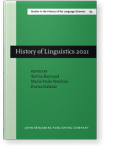Chapter 12
The relevance of B. Delbrück’s work on Indo-European syntax
(a century after his death)
Delbrück’s work on Indo-European syntax, particularly his contribution to the analysis of Vedic
syntax, is still a useful tool for those wanting to deal with the study of Old Indian and Indo-European comparative
syntax. Indeed, it is methodologically comparable with the recent analyses of the left periphery of the sentence. In
fact, the notions of basic order of the major constituents of the sentence and of marked order are already present in
Delbrück’s 1878 work, together with formal considerations that relate
the variation of the order of constituents to the interface between the syntax and information structure of the
sentence.
Article outline
- 1.On PIE word order: Delbrück vs. Braune
- 2.Non-configurational languages
- 3.Configurationality and Indo-European
- 4.The opposition between ‘traditionelle’ and ‘occasionelle Wortstellung’
- 5.Examples of traditional and occasional order
- 6.Looking for a VP in Sanskrit
- 7.Clitics in Delbrück (1878)
- 8.Verb-initial sentences due to textual cohesion
- 9.Reception of Delbrück’s work in recent years
- 10.The Occasionelle Wortstellung as a historical explanation
- 11.Amplified sentences
- 12.Occasionelle Stellung and Left Periphery
- 13.Conclusions
- Author queries
-
Notes
-
References
This content is being prepared for publication; it may be subject to changes.
